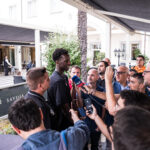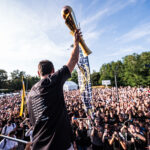Bologna –
Virtus Segafredo Bologna Ceo Luca Baraldi’s interview with “La Gazzetta di Parma” today:
Two separate rescue operations- conducted between January 2003 and June 2005-which bear Luca Baraldi’s signature at the bottom of the page. “Especially when I think back to the sense of loneliness of the initial days, particularly in Rome,” begins the executive, current CEO of Virtus Bologna. “As things got better, the list of people ready to jump on the bandwagon got longer. But later, precisely. Never in the early stages. It always works more or less like this. Early in 2003, I get the call from Dr. Livolsi of Rothschild, advisor to the Cirio group: he offers me the position of managing director and general manager of the club. I immediately think that I was put there because it had to be a ‘foreign priest,’ and not one from the capital, to celebrate Lazio’s funeral. In any case, I accept and start working. Just three years earlier Lazio had won the Scudetto. The fans were depressed, mortified by a situation that had plunged them into an abyss. The players had opted to put the club on notice: of the 20 days available after this act, there were 5 or 6 days left when I arrived. There was no time to waste.”
And this is where the “Baraldi plan” takes shape.
“I was young, I had a thousand ideas. Of that experience I remember first of all the valuable advice of President Ugo Longo, prince of the Rome Forum: he had an endless knowledge of the Lazio world. He explained to me what it was like to administer such a company. In my own hotel, on the other hand, live the commissioners of Cirio, who are called upon to find a solution for the creditors. We compare notes often. I think you can borrow that same idea and apply it to soccer, proposing that players become partners.”
An entirely unexplored avenue in the world of football.
“Exactly. That is why the plan is met with a certain diffidence: in the collective imagination it was unthinkable that the players would become shareholders in their own club that was about to go bankrupt. The same, according to that plan, creditors and suppliers would have to do. It was like moving through a minefield, because Lazio was a listed company: in short, there were other management constraints, beyond those related to sports law.”
How is the team taking it?
“I can’t say it was a bitter confrontation, but of course not easy either. There were strong personalities in that group: I like to remember the great men before the absolutely valuable players. A committee had been formed with Peruzzi, Marchegiani, Pancaro, Favalli and Giannichedda. And then the various Mihajlovic, Simeone. The coach was Roberto Mancini. They had been given so many promises by previous managers, who had taken their time: they didn’t trust them anymore, it was obvious.”
He finally convinces them.
“Great guys. All of them. By accepting the Baraldi plan they saved their contracts, but they saved Lazio first. Even the suppliers, instead of losing everything, chose to turn their claims against the club into shares to be placed on the market later, so they could get back what they were owed. And the significance of that operation was also significant in another respect. The preservation of jobs. The same thing would happen later in Parma. At that time Lazio had over 100 employees.”
A miracle that in the case of that Lazio is also sporting.
“Fourth place sends us to the Champions League preliminaries. In the summer we sell Simeone to Atletico Madrid: interviewed by a Roman newspaper, Diego says I was one of the best managers he had met in his long career. We launch the season ticket campaign putting our faces, in the true sense of the word: Longo, me and Mancini. The city entirely plastered with posters depicting us together. The response is exceptional: 34 thousand cards subscribed.”
From Lazio to Parma: again it all happens under the Christmas holidays.
“I ended my relationship with the biancocelesti in December 2003: Mancini had renewed for three years and a similar proposal Banca di Roma, which was the club’s major shareholder, had made to me. I went back to Parma. Fifteen days later there is the Parmalat crash: Enrico Bondi calls me at home, asking for a meeting. In Collecchio we close the deal in five minutes.”
A second mountain to climb.
“More. There was also a very strong emotional involvement in this adventure: Parma is my favorite team. Despite all the difficulties, we almost make it to the Champions League. The city is with us: the closeness of fans and business fabric is even moving.”
Champions dream broken by former Adriano. Sacrificing the Brazilian ace was inevitable, wasn’t it?
“Yes. Those 24 million euros for half of a card that Sacchi and I had taken from Inter practically for free represented the capital that allowed us to move forward (and save Parma). The great thing is that we were able to do this thanks to market operations made during my previous management. Not only Adriano: we had also taken Gilardino, later sold to Milan in the summer of 2005, and Bonera. As well as Mutu and Bresciano, who did great things. We had chosen to focus on young people, after saying goodbye to the big names: my first operation as manager of Parma had been the sale of Buffon to Juve for 105 billion old lire, followed closely by that of Thuram for 80.”
The salvation won in Bologna is worth as much as a Scudetto.
“We were a family. Even Sebastien Frey, a generous boy like few, recalled this recently. A united group, with Gedeone Carmignani on the bench and Lorenzo Minotti team manager: we could challenge anyone. Like at Lazio, there were exceptional guys here, too.”
After Bologna, Baraldi leaves.
“I had made a promise to Bondi: If we are saved, I will give up the almost two years of my remaining contract. It was a choice of ‘love. Of this club, of this jersey, of this city. The mission was accomplished: we had saved the club, outside and inside the playing field. It was right for me to leave in my moment of glory. Bondi understood and appreciated “.













